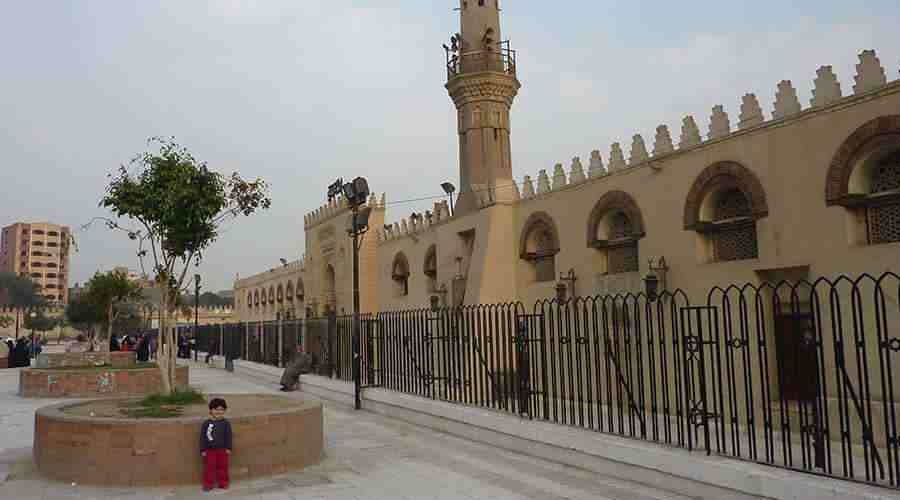Amr Ibn Al Aas mosque Cairo tours, booking, prices, reviews
Amr Ibn Al Aas mosque Cairo is the first and oldest mosque which built on the land of Egypt. In fact, the mosque of Amr Ibn Al Aas erected in 642 AC by Amr Ibn Al Aas. He was the commander of the Muslim army that conquered Egypt. The mosque in fact also known as Taj Al Jawamie (Crown of Mosques. It also Known as Al Jamie Al Ateeq (the Ancient Mosque). And it also known as Masjid Ahl Al Rayah (Mosque of Banner Holders). In fact, the mosque built on the site of Amr Ibn Al Aas’s tent at Fustat. It is the oldest existing mosque, not just in Cairo, but the entire African Continent. Amr Ibn Al Aas Mosque located north of the Roman Fortress of Babylon. It actually on the edge of Fustat, the temporary city founded by Amr.
In fact, it was an Islamic learning center long before Al Azhar mosque. Moreover, it could hold up to 5,000 students. The mosque built on an area of 1,500 square cubits, overlooking the Nile. The initial structure was quite simple; with walls bare of any plaster or decorations. But it was without niche (Miharb), minaret or ground cover. It had two doors on the north and two others facing Amr’s house. Amr Ibn Al Aas Mosque Cairo area remained unchanged until 672. When Musallama Al Ansari undertook expansion and renovation works for the mosque. He was Egypt’s ruler on behalf of Caliph Mu’awiya Ibn Abi Sufian. Walls and ceilings decorated. Four compartments for “muezzins” (callers for prayers) added at the corners.
Further details about the mosque:
They are together with a minaret, while the mosque ground covered with straw mats. In 698, the mosque demolished and expanded by Abdul Aziz Ibn Marwan, Egypt’s ruler. Once again in 711, the mosque demolished by Prince Qurrah Ibn Shuraik Al Absi, Egypt’s ruler. Upon the orders of Caliph Al Waleed Ibn Abdul Malek, the mosque area enlarged. A niche, a wooden pulpit, compartment and copings of four columns gold-coated. The mosque had then four doors to the east, four to the west and three to the north. Under the Abbasid state, successive additions and repairs introduced. In 827, Abdullah Ibn Taher, Egypt’s ruler on behalf of Caliph Al Ma’moun ordered an equal area to the north.
That is to added to the mosque, thus bringing its total area to its present level of 13,556,25 square meters. (112.3 m x 120.5 m). The Fatimid period was the gold era for Amr Ibn Al Aas Mosque Cairo. Gilted mosaics, marble works, a wooden compartment and a moving pulpit introduced. A part of the niche was silver-coated. The last structural amendments in the mosque made during the rule of Murad Bey. It was under the ottoman era, in 1797 AC. There was a collapse of some columns. That is why the interior of the mosque demolished and rebuilt. As a result, eastern arcades re-positioned to be perpendicular to the Mihrab wall. Arches extended across windows. Two minarets built and are still extant.
More details about Amr Ibn Al Aas Mosque Cairo:
The mosque was not only a place of worship. In fact, it also served as a court for settling religious and civil disputes. Teaching circles organized either for general religious preaching or teaching lessons. It was in Quranic sciences and jurisprudence. Moreover, it also was in Prophet Muhammad’s Tradition (Hadith) as well as letters. Amr Ibn Al Aas Mosque Cairo incorporates elements of Greek and Roman buildings. It has 150 white marble columns and three minarets. Its present plan consists of an open Sahn (court). Sahn surrounded by four Riwaqs, the largest being the Qiblah Riwaq. There are many wooden plaques bearing Byzantine carvings of leaves. An enclosed column has transported from Mecca on the orders of Prophet Mohammad himself. There are many other ancient legions which related to the Mosque.
















